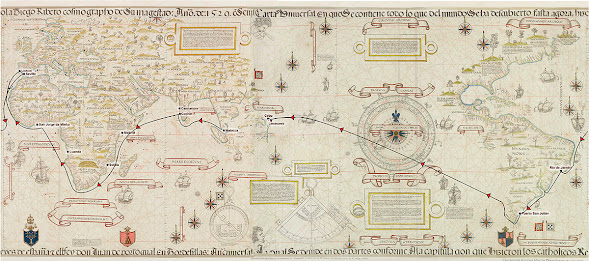.jpg) |
| Modern-day replica of Magellan's Nao Victoria, first ship to circumnavigate the globe. Source |
Sixteenth-century carracks gave Portugal and then Spain the ability to reach—and conquer—cities at the farthest corners of the earth: India in 1498, Malacca in 1509, the Malukus in 1512[*] by Portugal, and the Philippines in 1521 by Ferdinand Magellan sailing for the Spanish, the long way across the Pacific Ocean.
The vessels had to carry men, provisions, cargo, and cannon. Magellan’s fleet of five carracks carried between thirty and fifty crewmen per ship.
Below are some of the key components of carracks.
Hull: The main body of the ships, made from sturdy timber sometimes grown to specified shape to form the carrack’s framework.
Decks: Multi-leveled platforms within the hull where crew worked and slept.
Forecastle: A raised platform at the front of a ship. Carracks were known for high forecastles and sterncastle, which offered better visibility and served as a raised, shielded platforms for fighting.
Sterncastle: A raised platform at the rear of a ship. Sterncastles (or aftercastles) also held officers’ quarters, and storage.
Masts: Carracks had three and sometimes four masts, including the mainmast, foremast, and mizzen mast. Magellan’s fleet of five vessels all had three. The combinations of square and latten sails on the three masts gave carracks greater maneuverability.
Sails: Carracks added lateen sails to traditional square sails. Lateen sails allowed them to tack against the wind and gave the Portugues the ability to sail sough in search of African gold (and later slaves). Arab sailors first developed lateen sails, likely based on a Malay prototype.
Rudder: Rudders off the rear were vital in steering carracks. They were unsophisticated, operated by an arm[*]. Later vessels would add ships’ wheels as a system of controlling rudders.
Cannon: Carracks used for “exploration” were well armed with cannon, for defense, for impressing and/or terrifying, and for punishing towns and cities that resisted Portuguese and Spanish advances.
Carronades: Smaller, cannon used for short range, which were easier to handle.
Anchors: Heavy metal devices that kept ships stationary and stable when not under sail.
Bilge Pumps: Pumps that worked to remove bilgewater that seeped into the hull, a constant battle for carracks and later vessels.
Capstan: A revolving cylinder with a vertical axis used for winding a rope or cable; used for raising the anchor and hauling heavy loads on board.
Galley: The ship's kitchen and dining area, though on the early carracks, meal preparation took place on deck, as well.
Cargo Holds: Storage areas below deck that held provisions and supplies, merchandise to trade, cargo obtained in trading. Most carracks had a sizeable cargo area specifically designated for barrels of wine and water.
Quarters: On early carracks, only top officers had indoor quarters, usually located on the sterncastle. Crew typically slept on deck or below deck where they could find space, during storms or ill weather.
 |
| Reconstruction of the Danish 15th-century carrack Gribshunden by Mats Vänehem. Source. |
 |
| Map of Enrique of Malacca's circumnavigation: Malacca, Lisbon, Seville, Rio de Janeiro, Puerto San Julián, Guam, Limasawa, Cebu.[1] |
On March 28, 1521, Enrique of Malacca became the first person to complete a linguistic circumnavigation of the globe—he traveled so far in one direction that he reached a point where his own language was spoken. Enrique’s journey began a decade earlier following the sack of Malacca, when he was taken as a slave by Ferdinand Magellan. A teenager, he accompanied Magellan back to Portugal, then to Spain, and finally on the Armada de Molucca to locate a westward route to the Spice Islands. More about Enrique of Malacca.
